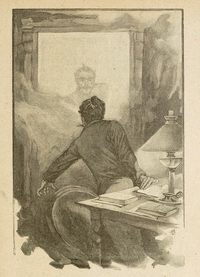| "The Horla" | |
|---|---|
| Short story by Guy de Maupassant | |
| Original title | Le Horla |
| Country | France |
| Language | French |
| Genre(s) | Horror |
| Publication | |
| Publication date | 1887 |
"The Horla" (French: "Le Horla") is an 1887 short horror story written in the style of a journal by the French writer Guy de Maupassant, after an initial (much shorter) version published in the newspaper Gil Blas, October 26, 1886.

The story has been cited as an inspiration for Lovecraft's "The Call of Cthulhu", which also features an extraterrestrial being who influences minds and who is destined to conquer humanity.[1]
The word horla itself is not French, and is a neologism. Charlotte Mandell, who has translated "The Horla" for publisher Melville House, suggests in an afterword that the word "horla" is a portmanteau of the French words hors ("outside"), and là ("there") and that "le horla" sounds like "the Outsider, the outer, the one Out There", and can be transliterally interpreted as "the 'what's out there'".[2]
In the form of a journal, the narrator, an upper-class, unmarried, bourgeois man, conveys his troubled thoughts and feelings of anguish. This anguish occurs for four days after he sees a "superb three-mast" Brazilian ship and impulsively waves to it, unconsciously inviting the supernatural being aboard the boat to haunt his home.

All around him, he senses the presence of a being that he calls the "Horla". The torment that the Horla causes is first manifested physically: The narrator complains that he suffers from "an atrocious fever", and that he has trouble sleeping. He wakes up from nightmares with the chilling feeling that someone is watching him and "kneeling on [his] chest".
Throughout the short story, the main character's sanity, or rather, his feelings of alienation, are put into question as the Horla progressively dominates his thoughts. Initially, the narrator himself questions his sanity, exclaiming "Am I going mad?" after having found his glass of water empty, despite not having drunk from it. He later decides that he is not, in fact, going mad, since he is fully "conscious" of his "state" and that he could indeed "analyze it with the most complete lucidity." The presence of the Horla becomes more and more intolerable to the protagonist, as it is "watching ... looking at ... [and] dominating" him.
After reading about a large number of Brazilians who fled their homes, bemoaning the fact that "they are pursued, possessed, governed like human cattle by ... a species of vampire, which feeds on their life while they are asleep ... [and] drinks water", the narrator soon realizes the Horla was aboard the Brazilian three-mast boat that he had previously greeted. He feels so "lost" and "possessed" to the point that he is ready to kill the Horla. The narrator traps the Horla in a room and sets fire to the house, but forgets his servants, who perish in the fire. In the last lines of the story, faced with the persistence of the Horla's presence, he concludes suicide to be his only liberation.
Relating the advent in France of an invisible being who lives on water and milk, sways the minds of others, and seems to be the vanguard of a horde of extra-terrestrial organisms arrived on earth to subjugate and overwhelm mankind, this tense narrative is perhaps without peer in its particular department.